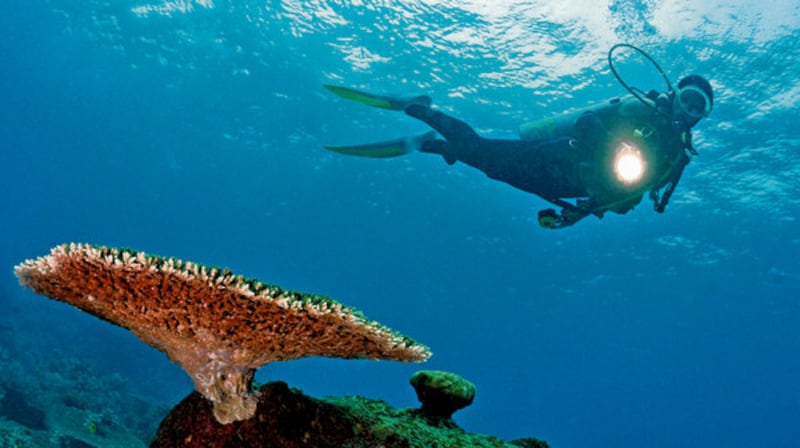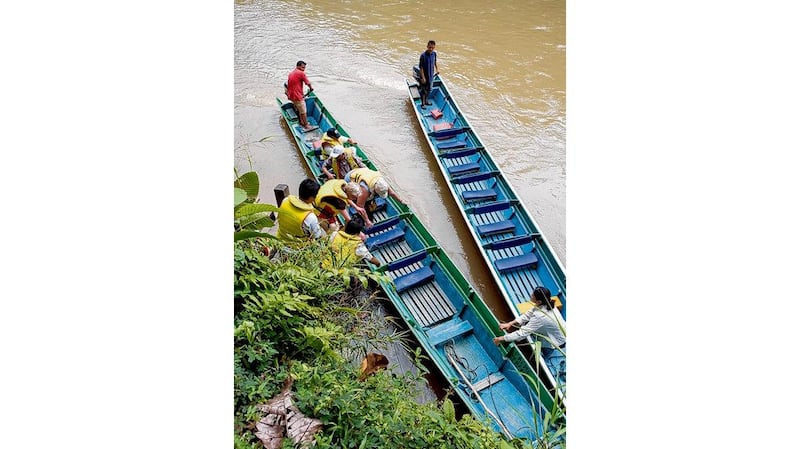In a corner of Malaysian Borneo, PETER MCGUIREtracks down the Bajau Laut - a seafaring people who live and die on their boats
Borneo: orangutans and rainforests jump to mind. But this ancient island, shared with relative harmony by Malaysia, Indonesia, and the tiny but vastly wealthy kingdom of Brunei, is also home to the best scuba diving in the world.
Despite being just a few miles from Sipadan, arguably the world’s best dive site, I had no intention of learning to breathe under 18m of water. I’d come to Semporna in this corner of Malaysian Borneo for a temporary respite from rainforest trekking and leeches. More importantly, I had come to track down the Bajau Laut, seafaring gypsies who are born, live and die on their boats, setting foot on land only when it is absolutely necessary.


The Semporna archipelago is dotted with clear coral seas and the simple stilt houses of the Bajau Laut stretching several miles from the coast. I decided to spend a few days on Singamata, a floating coral hotel on stilts, some distance out to sea. I would swim. I would stretch my legs. I would relax and reinvigorate.
I quickly discovered that it was incredibly quiet, with very few guests and very little to do; too much beach time quickly led to me to signing up for my basic Padi diving qualification.
I regretted it immediately. From start to finish, learning to dive amounted to a constant battle against the fear that I may panic under the water and make a stupid and possibly fatal error.
I ploughed through. On day two, after a few hours’ practice, the Bajau Laut floated towards us with a serene calm on a peaceful sea. Their houseboat was low and long with a large, covered cabin. A mother and father washed dishes while their nimble, happy children jumped into the water and swam with an ease and grace that would embarrass a fish. According to some local lore, the Bajau-laut are, increasingly, born with webbed feet. The sea is who they are.
Their boat drifted slowly, its diesel engine turned off on account of the gentle breeze that guided them closer to us. One of the children stuck their nose out of the sea, much as a seal or porpoise might, and promptly disappeared under the water again. I waited for him to emerge. I kept waiting. Eventually, I asked if we should be worried. My dive instructor smiled wryly and said nothing. On the houseboat, the boy’s mother hummed a tune and continued with her chores.
Several minutes later, the boy emerged grinning, barely seeming to catch a breath. He was at home under the water; diving without air was as natural to him as walking is to me. I resolved to toughen up, but the rest of the day was still an endurance of mask flooding, emergency ascents, and my only source of oxygen being ripped from my body.
My course ended with an unexpectedly difficult exam. I just about passed, patted myself on the back for my great achievement, and immediately resolved never to dive again.
The next day, I went in search of more Bajau Laut. As romantic as their lifestyle appears, they are the victims of major prejudice. Stateless and subject to imposed policies of forced settlement, their unique seaborne way of life is under constant threat. They flee persecution in the Philippines and many end on the shores of this impossibly idyllic paradise in Semporna.
My search took me to Mabul Island. As well as being known for its lovely stilt houses rising from the sea, it’s also one of the most famous and revered dive sites in the world, boasting coral sharks, innumerable sea turtles, and barracudas. Mabul’s reputation is built on the back of nearby Sipadan, a spectacular coral reef that grew on an extinct volcano, and features some of the richest biodiversity in the marine world alongside an awesome 600ft drop into a deep, dark abyss. Mabul itself has been sneaking up on the inside, and is increasingly recognised as one of the best “muck diving” sites, where you’ll find a host of more exotic and unusual organisms. But who cares? I’d come here to find the Bajau Laut and then sit around.
I arrived on Mabul at a very fortuitous time. My hotel, the Mabul Island Beach Resort – a rather luxurious budget beachfront accommodation run by the Scuba Junkie company – had been sheltering and protecting green turtle eggs in a hatchery for several months. That afternoon, the first of 111 baby green turtles hatched, and the rest of the eggs popped open as the light shortened. As dusk closed in and slowly turned to dark, tourists and locals gathered to watch as the baby turtles were carefully released on to the beach.
Instinct dragged the babies towards the sea and they vanished into the swell. Most will die within a year but those who survive can look forward to some 80 years of life.
The next day, I walked around the tiny Mabul Island in less than half an hour, doing my best not to stare with curiosity at the seaborne Bajau and the land-based Dusun, an ethnic group comprised primarily of Islamic Filipino refugees without Malaysian citizenship rights.
Despite what seemed to my western mind like a tourist attraction made in an evil capitalist dream, there’s little opportunity for foreigners to interact with the Bajau Laut. They are all at sea, and I was all at land. There are no cultural displays, no tacky dances for tourists, no dedicated museum: the Bajau Laut are simply a constant and intriguing presence.
Later, after some gentle persuasion from other hotel guests, my resolve never to dive again weakened. I signed up.
I only paid for one dive rather than bargain rate for three, and consoled myself that it would all be over soon. On the next tropically perfect day, I gingerly climbed aboard the boat with the other divers, surrounded by the Bajau Laut’s colourful boats, and was briefed as we headed out to sea. I strapped on the gear, took a deep breath, and rolled into the sea.
Descend slowly. Equalise your ears by holding your nose and blowing out as you descend. Focus on your breath. And very soon, I was diving 18m below the surface, at the edge of a coral shelf. Shortly after, the first curious giant sea turtle approached. Awestruck, I just about remembered to keep breathing.
Anyone who has ever learned meditation or yoga knows that their power lies largely in the ability to focus on the breath, a process which necessitates forgetting about all the banal and pointless thoughts that plague our daily lives.
What will I have for dinner? What did she mean by that? Will I have enough money to buy it? But learning to control your drifting thoughts takes time and practice, and some people never quite achieve it.
With diving you very quickly learn that if you don’t focus on your breath, you will die. It’s a reasonably good incentive to block out all that mindless chatter that clogs up the arteries of your brain. And so, the world above the water ceases to exist and you can only exist in the present.
Focus on your breath, and be surrounded by an astonishing array of multicoloured reef fish. Nudibrachs. Scorpionfish. A whopper that looked like a potato ( called a potato grouper). Giant moray eels. Stingrays. Parrotfish. Barracudas. At one point, I found myself in the midst of a school of thousands of jackfish, and tears of joy welled up in my eyes as I tried not to laugh. Another giant, majestic, mysterious turtle passed by and rolled his eyes to heaven at the state of me.Too soon, it was time to go up again. I immediately signed up for a second dive, and a third. I had a flight the next day, so a fourth was off the cards.
Back under the water, I once again wasn’t just in another world; my own world simply ceased to exist. Nothing can bring peace and exhilaration like diving. It is a genuinely transformative, even spiritual, experience. Months later, and I’m smiling. I’m so glad I stuck it out. The magic that keeps the Bajau-laut at sea has become wonderfully real.
GETTING THERE:
KLM flies Dublin to Kuala Lumpur from €728 return. Aer Lingus flights from €809 return.
From within southeast Asia,
you’ll find cheap flights with Air Asia from many cities.
Once you’re in Malaysia’s capital, catch a short connecting flight to Tawau with budget airline Air Asia, from €25 one way. From the airport, a private taxi to Semporna costs about €20, while a bus will cost about €4.
WHERE TO STAY
Budget:Mabul Beach Resort opens up to the beach and draws in the flashpacking crowd, with good dive packages, decent food, and spotless accommodation. Rather plush dorm beds from €20 per night, with chalet rooms from €36-65.
[ scubajunkie.comOpens in new window ]
Luxury:The Mabul Water Bungalow is a series of chalets with Balinese design gliding out into the Celebes Sea. They are utterly amazing. One room has a glass floor revealing the starfishcovered sea. Three-day, two-night dive package costs €770. mabulwaterbungalows.com
WHEN TO GO
Rainy season is mid-December to mid-February but it can rain any time in Borneo, which is dominated by rainforest. Best diving months are April to November. The Regatta Lepa festival, when the Bajau Laut come to land for a colourful and vibrant festival, is held in April.
